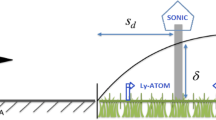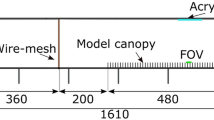Abstract
We propose a method for estimating the convective-heat-transfer coefficient (CHTC) distribution on building walls by using the water-evaporation method involving filter paper and three-dimensional laser scanning, and demonstrates consistency with the gravimetric evaporation method. The theory and method are established based on the convective heat- and mass-transfer analogy and a near-infrared laser-scanning system. The equations to remotely estimate the CHTC distribution are obtained empirically, and the proposed method is applied to the walls of a penthouse during winter. The spatial distribution of the surface reflection intensity that determines the evaporation rate is successfully retrieved with 0.2–0.3% accuracy from a measurement distance of 5 m. The comparison of evaporation rates with a gravimetric measurement does not show a statistically significant bias. The results show that the crucial factors for the precision of the CHTC estimation are errors in the laser-scanning system and their amplification when dividing the evaporation rate by the vapour pressure deficit to obtain the convective-mass-transfer coefficient. The estimated CHTC distributions on the target walls have approximately ≤ 2–3 W m−2 K−1 errors in the 95% confidence interval after applying spatial and/or temporal averaging. Although the error in the convective-heat-transfer coefficient is larger in winter during minimal vapour pressure deficits, it is generally well explained in the range of the random error in laser scanning. The correlation between the spatially-averaged convective-heat-transfer coefficient and near-wall wind speed is comparable to existing methods (R = 0.71–0.79), and the regression relation agrees with that obtained in previous studies performed in similar conditions.















Similar content being viewed by others
References
Barlow JF, Belcher SE (2002) A wind tunnel model for quantifying fluxes in the urban boundary layer. Boundary-Layer Meteorol 104:131–150
Barlow JF, Harman IN, Belcher SE (2004) Scalar fluxes from urban street canyons. Part I: laboratory simulation. Boundary-Layer Meteorol 113:369–385
Bird RBB, Stewart WE, Lightfoot EN (2006) Transport phenomena, Revised 2nd edn. Wiley, New York/Chichester/Weinheim/Brisbane/Singapore/Toronto, pp 682–683
Campbell GS, Norman JM (1998) An introduction to environmental biophysics, 2nd edn. Springer, Netherlands, p 286
Chung J, Hagishima A, Ikegaya N, Tanimoto J (2015) Wind-tunnel study of scalar transfer phenomena for surfaces of block arrays and smooth walls with dry patches. Boundary-Layer Meteorol 157:219–236
Clear RD, Gartland L, Winkelmann FC (2003) An Empirical correlation for the outside convective air-film coefficient for horizontal roofs. Energy Build 35:797–811
Cole RJ, Sturrock NS (1977) The convective heat exchange at the external surface of buildings. Build Environ 12:207–214
Fang HT, Huang DS (2004) Noise reduction in lidar signal based on discrete wavelet transform. Opt Commun 233:67–76
Gaulton R, Danson FM, Ramirez FA, Gunawan O (2013) The potential of dual-wavelength laser scanning for estimating vegetation moisture content. Remote Sens Environ 132:32–39
Goldstein RJ, Cho HH (1995) A review of mass transfer measurements using naphthalene sublimation. Exp Therm Fluid Sci 10:416–434
Hagishima A, Tanimoto J (2003) Field measurements for estimating the convective heat transfer coefficient at building surfaces. Build Environ 38:873–881
Hagishima A, Tanimoto J, Narita K (2005) Intercomparisons of experimental convective heat transfer coefficients and mass transfer coefficients of urban surfaces. Boundary-Layer Meteorol 117:551–576
Hagishima A, Narita K, Sugawara H, Tanimoto J (2008) Field measurement on distribution of convective heat transfer coefficient within a real-scale urban canopy. J Environ Eng AIJ 73:511–518 (in Japanese)
Hancock S, Armston J, Li Z, Gaulton R, Lewis P, Disney M, Danson FM, Strahler A, Schaaf C, Anderson K, Gaston KJ (2015) Waveform lidar over vegetation: an evaluation of inversion methods for estimating return energy. Remote Sens Environ 164:208–224
Ikegaya N, Hagishima A, Tanimoto J, Tanaka Y, Narita K, Zaki SA (2012) Geometric dependence of the scalar transfer efficiency over rough surfaces. Boundary-Layer Meteorol 143:357–377
Jones HG, Vaughan RA (2010) Remote sensing of vegetation: principles, techniques and applications. Oxford University Press, Oxford, p 297 (Japanese edition)
Kanda M, Kawai T, Kanega M, Moriwaki R, Narita K, Hagishima A (2005) A simple energy balance model for regular building arrays. Boundary-Layer Meteorol 116:423–443
Kanomax Japan Inc. (2012) Climomaster model 6501 series multifunction anemometer: user’s manual. Accessed at https://www.kanomax-usa.com/sdm_downloads/climomaster-anemometer-6501-series-user-manual/on. 2019-09-21
Kusaka H, Kondo H, Kikegawa Y, Kimura F (2001) A simple single-layer urban canopy model for atmospheric models: comparison with multi-layer and slab models. Boundary-Layer Meteorol 101:329–358
Liu Y, Harris DJ (2007) Full-scale measurements of convective coefficient on external surface of a low-rise building in sheltered conditions. Build Environ 42:2718–2736
Martilli A, Clappier A, Rotach MW (2002) An urban surface exchange parameterisation for mesoscale models. Boundary-Layer Meteorol 104:261–304
Masson V (2000) A physically-based scheme for the urban energy budget in atmospheric models. Boundary-Layer Meteorol 94:357–397
Meinders ER, Hanjalić K (2002) Experimental study of the convective heat transfer from in-line and staggered configurations of two wall-mounted cubes. Int J Heat Mass Transf 45:465–482
Mirsadeghi M, Costola D, Blocken B, Hensen JLM (2013) Review of external convective heat transfer coefficient models in building energy simulation programs: implementation and uncertainty. Appl Therm Eng 56:134–151
Montazeri H, Blocken B (2018) Extension of generalized forced convective heat transfer coefficient expressions for isolated buildings taking into account oblique wind directions. Build Environ 140:194–208
Narita K (2007) Experimental study of the transfer velocity for urban surfaces with a water evaporation method. Boundary-Layer Meteorol 122:293–320
Narita K, Nonomura Y, Ogasa A (1997) Real scale measurement of convective mass transfer coefficient at window in natural wind: study on convective heat transfer coefficient at outside building wall in an urban area—part 1. J Archit Plan Environ Eng AIJ 491:49–56 (in Japanese)
Nusselt W, Jürges W (1922) Die kühlung einer ebenen wand durch einen luftstrom (The cooling of a plane wall by an airflow). Gesundheits Ingenieur 52:641–642
Oke TR, Mills G, Christen A, Voogt JA (2017) Urban climates. Cambridge University Press, Cambridge, p 84
Oleson KW, Bonan B, Feddema J, Vertenstein M, Grimmond CSB (2008) An urban parameterization for a global climate model part 1: formulation and evaluation for two cities. J Appl Meteorol Climatol 47:1038–1060
Palyvos JA (2008) A survey of wind convection coefficient correlations for building envelope energy systems’ modelling. Appl Therm Eng 28:801–808
Pascheke F, Barlow JF, Robins A (2008) Wind-tunnel modelling of dispersion from a scalar area source in urban-like roughness. Boundary-Layer Meteorol 126:103–124
Pinheiro JC, Bates DM (2000) Mixed-effects models in S and S-PLUS. Springer, Netherlands, pp 57–94 and 305–336
R Development Core Team (2019). R: A language and environment for statistical computing. R Foundation for Statistical Computing, Vienna, http://www.R-project.org/
Shao J, Liu J, Zhao J, Zhang W, Sun D, Fu Z (2009) A novel method for full-scale measurement of the external convective heat transfer coefficient for building horizontal roof. Energy Build 41:840–847
Sharples S (1984) Full-scale measurements of convective energy losses from exterior building surfaces. Build Environ 19:31–39
Wandinger U (2005) Introduction to lidar. In: Weitkamp C (ed) Lidar: range-resolved optical remote sensing of the atmosphere. Springer, Netherlands, pp 1–11
Acknowledgements
This study was supported by Japan Society for the Promotion of Science (JSPS) KAKENHI Grant No. 23686083. The authors express special gratitude to Dr. Prof. Akihito Ozaki, who gave lectures on the theory and formulations of water potential. The authors also thank Mr. Kento Murai and Mr. Hiroto Yamashita for their assistance.
Author information
Authors and Affiliations
Corresponding author
Additional information
Publisher's Note
Springer Nature remains neutral with regard to jurisdictional claims in published maps and institutional affiliations.
Appendix: Sensitivity of the Convective-Heat-Transfer Coefficient to Temperature Error
Appendix: Sensitivity of the Convective-Heat-Transfer Coefficient to Temperature Error
The effect of temperature error on \( e_{\text{s}}^{*} \) can be evaluated analytically by using the so-called August–Roche–Magnus relation
where \( T_{\text{s}} \) is in °C, \( e_{\text{s}}^{*} \) is the saturation vapour pressure [kPa], and a = 0.611 [kPa], \( b = 17.5 \) [°C], and c = 249.93 [°C] are typical atmospheric pressures (Campbell and Norman 1998). By using Eq. 9, the sensitivity (relative error) of the value of \( e_{\text{s}}^{*} \) to the temperature error can be expressed as
where \( \left| { - T_{\text{s}} /\left( {c + T_{\text{s}} } \right)} \right| \ll 1 \) results in
When \( T_{\text{s}} \) = 5–8 °C, which is a typical value in our measurement, Eq. 11 leads to \( \Delta e_{\text{s}}^{*} /e_{\text{s}}^{*} \approx 0.07\Delta T_{\text{s}} \). Assuming that the atmospheric relative humidity is 50% (which is the typical value here and that of a sunny day in Japan) and \( T_{\text{s}} \approx T_{\text{a}} \) (this seems a tolerable assumption for a shaded building wall), the sensitivity of the vapour pressure deficit is doubled and leads to a CHTC sensitivity \( \Delta h_{\text{c}} /h_{\text{c}} \approx 0.14\Delta T_{\text{s}} \).
Rights and permissions
About this article
Cite this article
Kiyono, T., Asawa, T. & Oshio, H. Laser-Scanning-Based Method for Estimating the Distribution of the Convective-Heat-Transfer Coefficient on Full-Scale Building Walls. Boundary-Layer Meteorol 178, 463–486 (2021). https://doi.org/10.1007/s10546-020-00578-x
Received:
Accepted:
Published:
Issue Date:
DOI: https://doi.org/10.1007/s10546-020-00578-x




